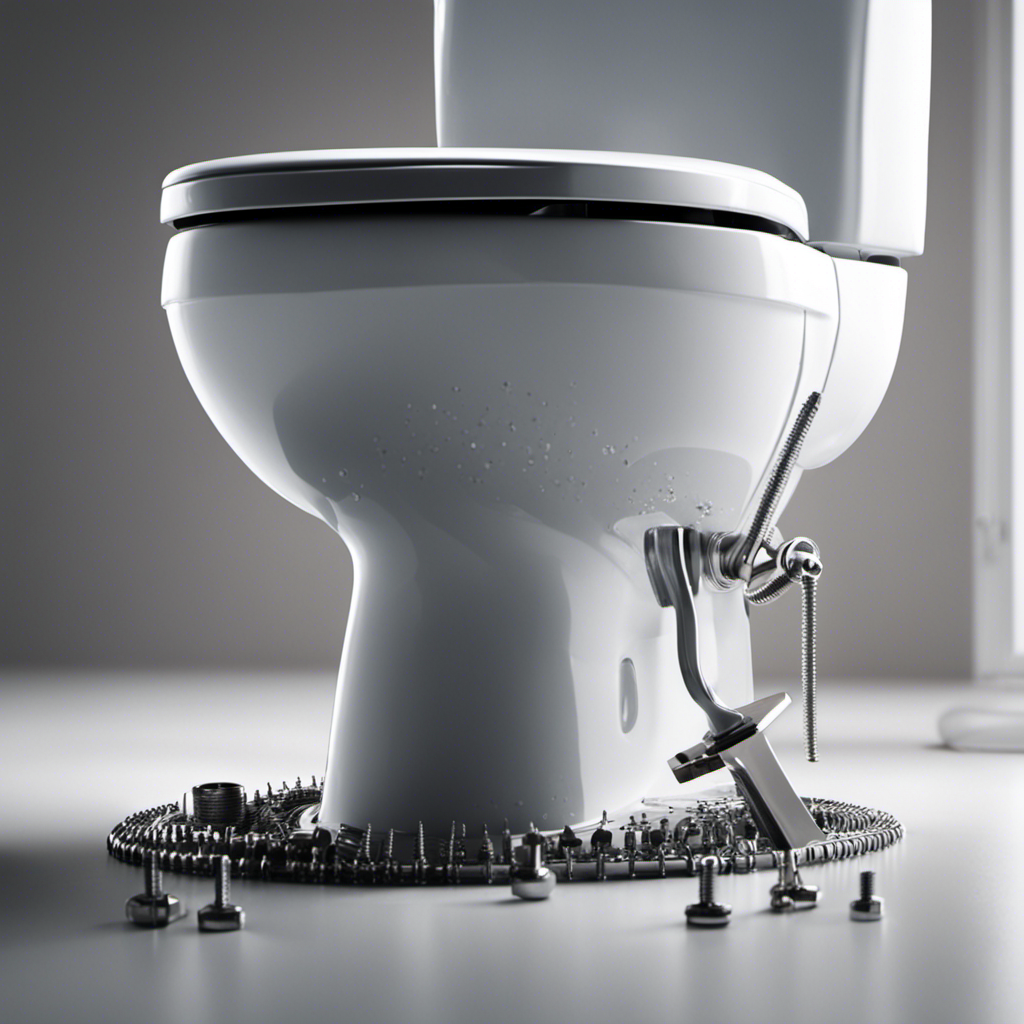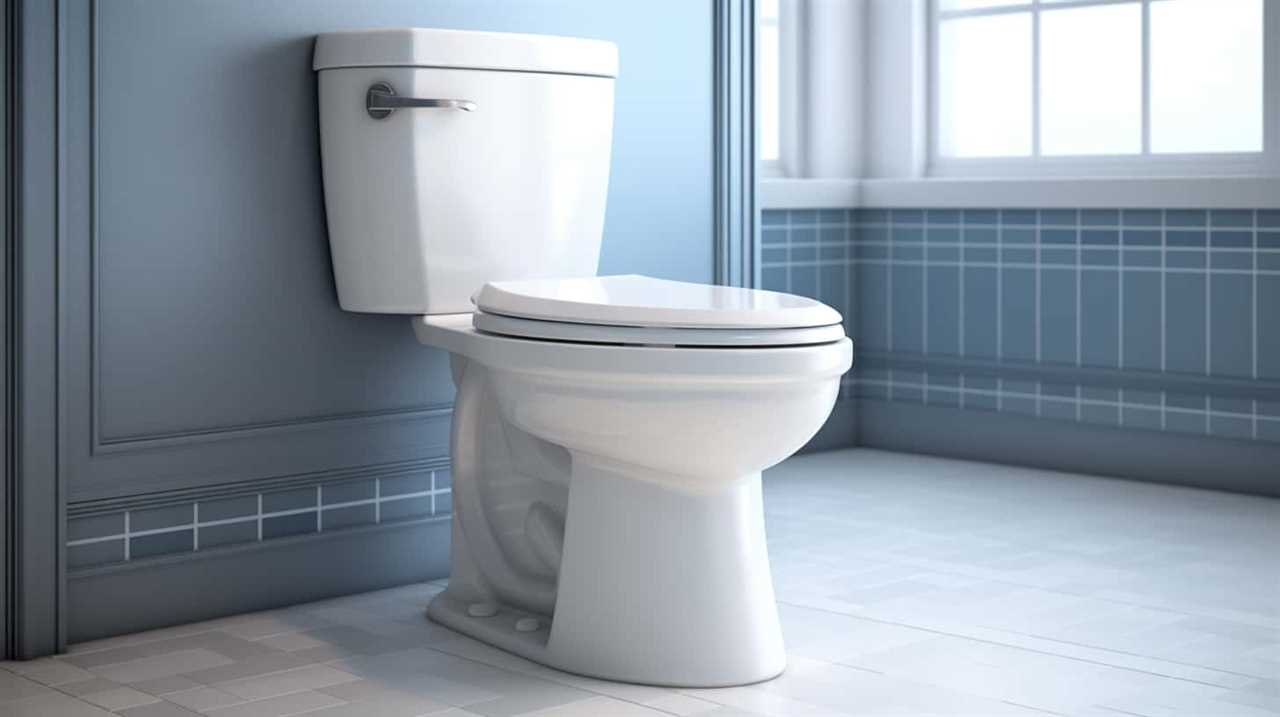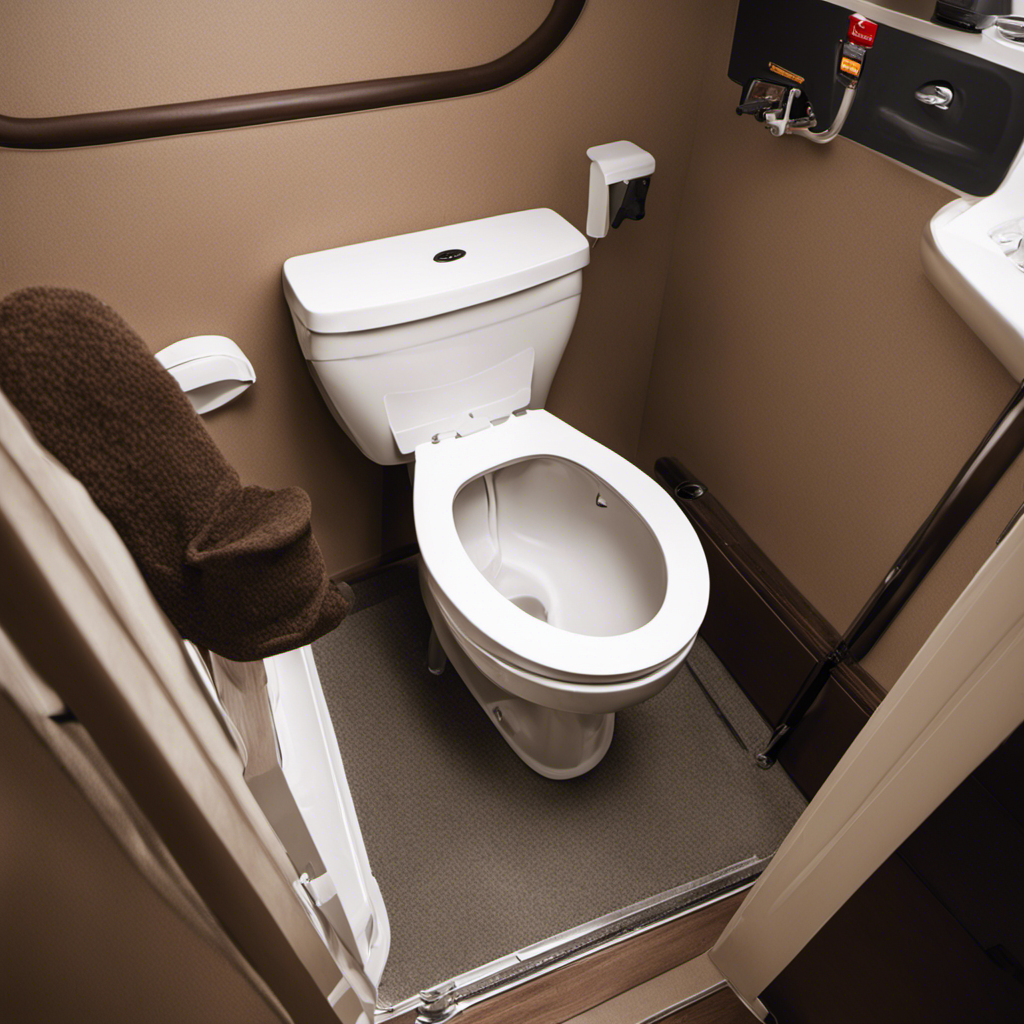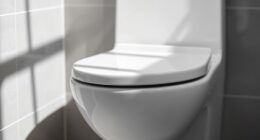If there’s one thing I’ve learned over the years, it’s that a wobbly toilet is no laughing matter. It’s not only an inconvenience, but it can also lead to more serious plumbing issues if left unattended.
Luckily, I’m here to share my tried and true method for fixing a wobbly toilet. With a few simple steps and some basic tools, you’ll have your toilet stable and steady in no time.
So let’s get started and put an end to that wobbly toilet once and for all.
Key Takeaways
- Loose bolts and damaged wax rings are common causes of toilet wobbling.
- Essential tools for fixing a wobbly toilet include a wrench, level, and shims.
- Choosing proper materials, such as sturdy toilet bolts and a reliable wax ring, is crucial.
- Using improper materials can lead to an unstable toilet installation.
Identifying the Cause of the Wobbling
Toilets can become wobbly due to loose bolts or a damaged wax ring. When faced with a wobbly toilet, it is important to identify the cause of the problem before attempting any repairs.
One common issue that leads to a wobbly toilet is loose bolts. These bolts secure the toilet to the floor, and if they become loose over time, the toilet can start to wobble.
Another common cause is a damaged wax ring. This ring creates a watertight seal between the toilet and the floor. If it becomes damaged or worn out, it can cause the toilet to become unstable.
By troubleshooting these common issues, you can pinpoint the cause of the wobbling and proceed with the necessary repairs.
Now, let’s move on to gathering the necessary tools and materials.
Gathering the Necessary Tools and Materials
When it comes to fixing a wobbly toilet, having the right tools is essential for achieving stability. A few key tools that I recommend having on hand include a wrench, a level, and some shims.
Additionally, choosing the proper materials, such as sturdy toilet bolts and a reliable wax ring, can make a significant difference in preventing future wobbling.
Lastly, it’s important to be aware of common mistakes to avoid, such as over-tightening the bolts or using inadequate shims, as these can lead to further instability.
Essential Tools for Stability
You’ll need a few essential tools to ensure stability when fixing a wobbly toilet.
The first tool you’ll need is a toilet anchor. This device helps secure the toilet to the floor, preventing it from wobbling or moving. Toilet anchors come in various types, such as flange bolts or expansion anchors, so choose the one that suits your toilet model.
Additionally, leveling shims are crucial for achieving a stable installation. These small wedges can be placed underneath the toilet to level it and eliminate any wobbling. It’s important to use high-quality shims made of sturdy material to ensure long-lasting stability.
Now that you have the necessary tools, let’s move on to the next section and discuss the importance of choosing proper materials for the job.
Choosing Proper Materials
Once you have the necessary tools, it’s important to choose proper materials for the job to ensure a stable installation. When it comes to fixing a wobbly toilet, there are a few factors to consider, including cost. Here is a table that outlines different material options and their cost considerations:
| Material | Cost |
|---|---|
| Rubber Shims | Affordable |
| Plastic Wedges | Low-cost |
| Metal Toilet Shims | Moderate-cost |
| Wax Rings | Higher-cost |
Rubber shims and plastic wedges are often the most affordable options, providing a quick and easy solution. Metal toilet shims offer a more durable choice but may come at a slightly higher cost. Wax rings, while the most expensive option, can provide long-lasting stability to your toilet installation. Consider your budget and the level of stability you desire when choosing the right materials for your wobbly toilet fix.
Common Mistakes to Avoid
One common mistake to avoid is using improper materials for the job, which could lead to an unstable installation. When fixing a wobbly toilet, it’s crucial to use the right tools and materials to ensure a sturdy and secure result.
Using subpar materials, such as weak or low-quality bolts, can cause the toilet to become loose and unstable over time. To avoid this mistake, always opt for high-quality and durable materials specifically designed for toilet installations. Additionally, make sure to follow the manufacturer’s instructions and guidelines when selecting and using these materials.
By using the proper materials, you can prevent future issues and ensure a stable and long-lasting toilet installation.
Removing and Reinstalling the Toilet Bolts
To remove and reinstall the toilet bolts, simply loosen the nuts using a wrench and lift the toilet off the floor. This step is necessary when replacing the wax ring or adjusting the toilet level.
Before beginning, it’s important to shut off the water supply to the toilet and drain the tank and bowl. Once the toilet is lifted, carefully set it aside on a towel or old newspaper to prevent any damage. Inspect the wax ring and replace it if necessary.
To reinstall the toilet, align the bolt holes with the toilet flange and gently lower it into place. Tighten the nuts on the bolts, being careful not to overtighten.
Now, let’s move on to checking and adjusting the toilet flange to ensure a secure and stable fit.
Checking and Adjusting the Toilet Flange
When it comes to ensuring the stability of a toilet, two key points to consider are flange alignment and tightening bolts for support.
Properly aligning the flange with the toilet base is crucial in preventing wobbling or shifting.
Additionally, securely tightening the bolts that connect the toilet to the floor will provide added stability and support.
Flange Alignment for Stability
Make sure you’re aligning the flange properly to ensure stability for your wobbly toilet. Here are three key reasons why flange repair is crucial for toilet stability:
-
Prevent Accidents: A wobbly toilet can be a safety hazard, especially for young children or elderly individuals. Properly aligning the flange will minimize the risk of the toilet tipping over and causing injuries.
-
Avoid Leaks: A misaligned flange can lead to leaks, causing water damage to your floor and surrounding areas. By repairing the flange, you can prevent costly repairs and potential mold growth.
-
Improve Flush Performance: A stable toilet with a well-aligned flange will provide better flush performance, ensuring efficient waste removal and preventing clogs.
Ensuring the stability of your toilet starts with aligning the flange properly. Once the flange is in position, it’s essential to tighten the bolts for additional support.
Tightening Bolts for Support
A simple step you can take to ensure added support is to tighten the bolts securely. This is an important task in stabilizing a wobbly toilet.
Start by locating the bolts at the base of the toilet, usually covered by plastic caps. Use a wrench to tighten them, but be careful not to overtighten and crack the toilet.
If the bolts are already tight and the toilet is still wobbly, you can try alternative methods such as using shims or installing a toilet stabilizing kit. These options can provide extra stability and prevent further movement.
However, if you’re not confident in your DIY skills, it’s always a good idea to seek professional assistance. Tightening the bolts is just the first step in stabilizing the toilet base and ensuring a secure and sturdy fixture.
Stabilizing the Toilet Base
To stabilize the toilet base, you’ll want to tighten the bolts holding it to the floor. This is an essential step in fixing a wobbly toilet and ensuring its stability. Here’s a practical guide to help you in this process:
-
Toilet Leveling: Before securing the bolts, make sure the toilet is level. Use a level tool to check if the toilet is sitting evenly on the floor. If it’s not, you may need to adjust the wax ring or use shims to achieve proper leveling.
-
Floor Preparation: Ensure that the floor beneath the toilet is clean and free from any debris. It’s important to have a smooth and stable surface for the toilet to sit on. If the floor is uneven, consider using a floor leveling compound to create a flat surface.
-
Bolt Tightening: Use a wrench to tighten the bolts securely. Start by tightening them evenly, alternating between the two bolts, until the toilet feels stable and doesn’t wobble anymore. Be careful not to overtighten, as this could crack the toilet or damage the floor.
Testing and Ensuring a Sturdy Toilet
One way to test the stability of your toilet is to sit on it and see if it feels sturdy.
However, there are other testing methods you can use to ensure that your toilet is secure and won’t wobble or rock when you use it.
One method is to check the bolts that hold the toilet to the floor. If they are loose, you can tighten them with a wrench.
Another method is to inspect the wax ring between the toilet and the floor. If it is worn or damaged, you can replace it to provide a better seal and stability.
Additionally, reinforcing the toilet with shims or using a toilet stabilizing kit can help eliminate any wobbling.
Frequently Asked Questions
Can I Use Regular Household Tools to Fix a Wobbly Toilet?
Yes, you can use regular household tools to fix a wobbly toilet. However, it’s important to avoid common mistakes when attempting this repair. Let me guide you through the process step by step.
Is It Necessary to Remove the Toilet Completely in Order to Fix the Wobbling Issue?
Removing the toilet may not be necessary to fix wobbling. I’ve found alternative methods, like using shims or tightening the bolts, to be effective. However, if unsure, it’s always wise to seek professional assistance.
How Do I Know if the Toilet Flange Is the Cause of the Wobbling?
To determine if the toilet flange is causing the wobbling, inspect it for cracks or damage. If the flange appears fine, check for other potential causes such as loose bolts or an uneven floor.
Should I Be Concerned About Any Potential Damage to the Floor When Stabilizing the Toilet Base?
Should I be worried about potential floor damage when stabilizing the toilet base? Well, let me assure you that there are prevention techniques available to avoid any harm to your floor.
How Can I Ensure That the Toilet Remains Sturdy After Fixing the Wobbling Issue?
To prevent future wobbling and ensure long-term stability of the toilet base, it is essential to properly tighten all bolts and nuts, use a stabilizing shim if necessary, and regularly check for any loosening or movement.
Conclusion
So there you have it, folks! By following these simple steps, you can easily fix a wobbly toilet and ensure a sturdy and stable bathroom fixture.
Remember, a wobbly toilet can lead to leaks and other plumbing issues, so it’s important to address the problem as soon as possible.
With just a few tools and some know-how, you’ll have your toilet back in tip-top shape in no time.
So go ahead, tackle that wobble and enjoy a solid and reliable porcelain throne fit for a king or queen!










